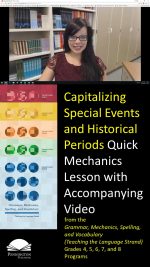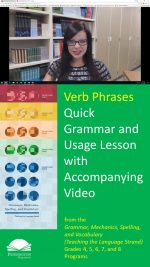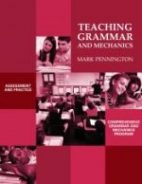Shifts in Verb Tense
Shifts in Verb Tense
Play the quick video lesson HERE and click the upper left back arrow to return to this lesson.
Common Core Language Standard 1
Time travel would definitely be an interesting experience. Not so much, however, if the time machine confused past, present, and future. The same is true in your writing. English allows us to change verb tense in the same paragraph and sometimes even within the same sentence, but only if you plan this shift in time. Confused verb tense reflects poor planning and, usually, poor proofreading.
Today’s grammar and usage lesson is on shifts in verb tense. Remember that a verb can mentally or physically act or serve as a state of being.
Now let’s read the grammar and usage lesson and study the examples.
Verb tense is the form of the verb that indicates time. There are three simple verb tenses: the past, present, and future. Examples: Mykah jumped, Mykah jumps, Mykah will jump.
Generally, keep the same verb tense in a sentence or group of related sentences. This is especially important with the past tense. However, when a change in time is necessary, it is certainly appropriate to change tenses, even within the same sentence.
Now circle or highlight what is right and revise what is wrong according to grammar and usage lesson.
Practice: Michael Jackson’s Thriller amaze audiences in 1987, and is an album that still gets plenty of radio play. Undoubtedly that continued for many years in the future.
Let’s check the Practice Answers.
Grammar and Usage Practice Answers: Michael Jackson’s Thriller amazed audiences in 1987, and is an album that still gets plenty of radio play. Undoubtedly that will continue for many years in the future.
Now let’s apply what we have learned.
Writing Application: Write your own sentence using an appropriate change in verb tense.
This writing opener is part of a comprehensive language conventions lesson from the Grammar, Mechanics, Spelling, and Vocabulary Grades 4‒8 programs.
*****

Pennington Publishing Grammar Programs
Teaching Grammar, Usage, and Mechanics (Grades 4, 5, 6, 7, 8, and High School) are full-year, traditional, grade-level grammar, usage, and mechanics programs with plenty of remedial practice to help students catch up while they keep up with grade-level standards. Twice-per-week, 30-minute, no prep lessons in print or interactive Google slides with a fun secret agent theme. Simple sentence diagrams, mentor texts, video lessons, sentence dictations. Plenty of practice in the writing context. Includes biweekly tests and a final exam.
Grammar, Usage, and Mechanics Interactive Notebook (Grades 4‒8) is a full-year, no prep interactive notebook without all the mess. Twice-per-week, 30-minute, no prep grammar, usage, and mechanics lessons, formatted in Cornell Notes with cartoon response, writing application, 3D graphic organizers (easy cut and paste foldables), and great resource links. No need to create a teacher INB for student make-up work—it’s done for you! Plus, get remedial worksheets, biweekly tests, and a final exam.
Syntax in Reading and Writing is a function-based, sentence level syntax program, designed to build reading comprehension and increase writing sophistication. The 18 parts of speech, phrases, and clauses lessons are each leveled from basic (elementary) to advanced (middle and high school) and feature 5 lesson components (10–15 minutes each): 1. Learn It! 2. Identify It! 3. Explain It! (analysis of challenging sentences) 4. Revise It! (kernel sentences, sentence expansion, syntactic manipulation) 5. Create It! (Short writing application with the syntactic focus in different genre).
Get the Diagnostic Grammar, Usage, and Mechanics Assessments, Matrix, and Final Exam FREE Resource:
![]()








